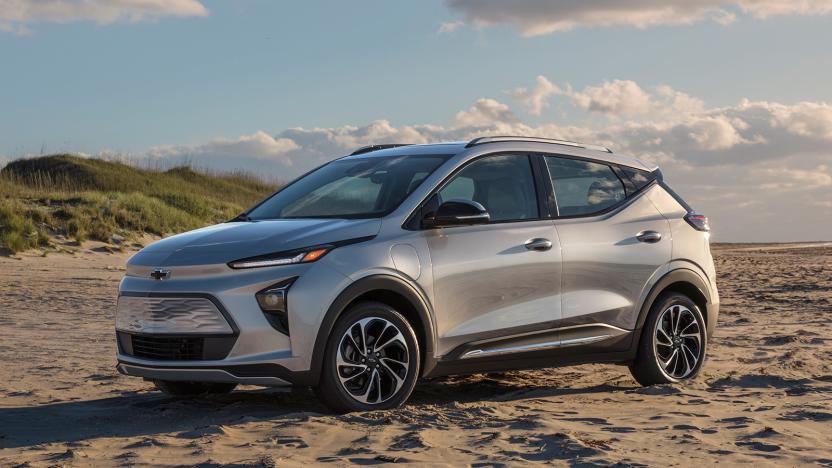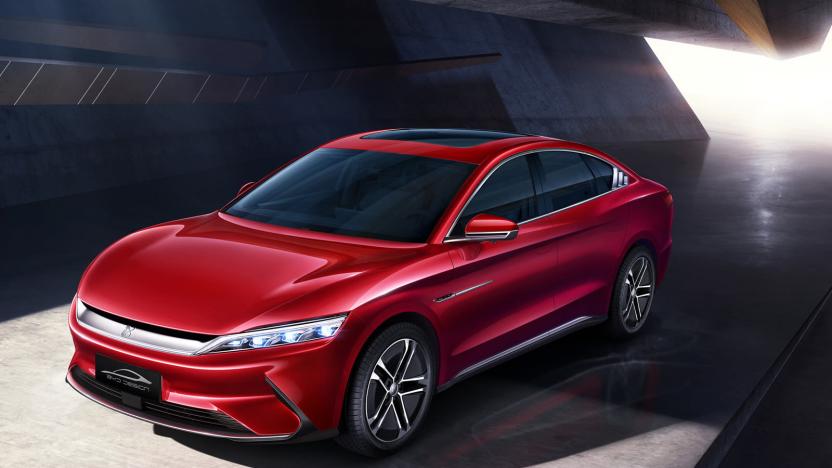lithium
Latest

How we built a less-explodey lithium battery and kickstarted the EV revolution
For the final installment of Hitting the Books for 2023, we're bringing you an excerpt from the fantastic Material World: The Six Raw Materials That Shape Modern Civilization by Ed Conway.

GM deal will reduce the environmental impact (and cost) of its EV batteries
GM has struck a deal that will reduce the environmental impact of its EV batteries by sourcing US lithium made using eco-friendly processes.

BYD's safety-oriented EV battery is less likely to catch fire
However much safer electric cars might be than their gas counterparts, they can still catch fire -- and BYD wants to reduce the chances of that happening. It will soon roll out a Blade Battery that's meant to be safer without compromising performance. Its high temperature for exothermic reactions, low (and slow) heat release and lack of oxygen release combine to form an energy pack that shouldn't "easily" catch fire. A nail puncture test didn't even significantly raise the temperature of the battery (it didn't venture above 140F), let alone set it ablaze. It also avoided fires due to bending, crushing, overcharging and overheating.

Researchers suggest 100 percent renewable energy isn’t very green
In order to keep global temperature rise below 1.5 degrees Celsius, we'll need to rely on renewable energy, electric vehicles (EV) and battery storage. But creating that infrastructure will dramatically increase our need for metals like cobalt and lithium. A report released this week cautions that a spike in demand for those and other metals could drain the planet's reserves and lead to dire social and environmental consequences.

EV batteries are born in Chilean evaporation ponds
Using Landsat data from the US Geological survey, NASA's Laren Dauphin recently imaged the Salar de Atacama in Chile. The enclosed basin is the world's largest source of lithium, producing 29 percent of the world's reserves. Much of it will wind up in rechargeable batteries used by EVs, laptops and smartphones, but how it gets there is surprising -- think salt production, not pit mines.

RIP Klout: The thing you didn't know was still a thing
Klout, the service that claimed to summarize every Twitter user's social reach and expertise into a tidy score, is shutting down on May 25th. In addition to its individual ratings, the company offered business analytics solutions and even partnered with Microsoft before it was acquired in 2014 by Lithium Technologies. Today, the latter's CEO Pete Hess tersely explained in a public post that Klout was shuttered because it is "not aligned with our long-term strategy."

Water purification could be the key to more electric cars
Humanity is going to need a lot of lithium batteries if electric cars are going to take over, and that's a problem when there's only so much lithium available from conventional mines. There may be an oddball solution for that, however: turn the world's oceans into eco-friendly mines. Scientists have outlined a desalination technique that would use metal-organic frameworks (sponge-like structures with very high surface areas) with sub-nanometer pores to catch lithium ions while purifying ocean water. The approach mimics the tendency of cell membranes to selectively dehydrate and carry ions, leaving the lithium behind while producing water you can drink.

UN group bans lithium battery shipments from passenger planes
Lithium-ion batteries, like those commonly used in laptops and smartphones, are no longer allowed to be shipped as cargo on passenger planes, the United Nation's International Civil Aviation Organization decided this week. There's no need to worry about your carry-on gadgets here -- the ruling applies only to shipments of lithium batteries in the cargo area of a commercial airliner. The new safety measure goes into effect on April 1st, and it should hold tough until ICAO and its partners can implement new, fire-resistant packaging standards for lithium batteries. That's expected to roll out by 2018.
![[Image credit: Shutterstock]](https://s.yimg.com/uu/api/res/1.2/5w5eKHoMZt81hVt28HfQ3A--~B/Zmk9ZmlsbDtoPTQ2ODtweW9mZj0wO3c9ODMyO2FwcGlkPXl0YWNoeW9u/https://o.aolcdn.com/dims-shared/dims3/GLOB/crop/4288x2580+0+118/resize/1400x843!/format/jpg/quality/85/https://o.aolcdn.com/hss/storage/midas/752372ce93efdde598d3e45c5d93e61c/202742077/stock-photo-closeup-of-the-hands-of-a-man-plugging-in-the-plug-of-his-smpartphone-in-a-socket-with-a-filter-260244584.jpg.cf.jpg)
Sony working on phone batteries that last 40 percent longer
Recent history has taught us we can't expect our smartphones to last more than a day on a single charge. Bigger batteries are an uninspired solution and fast-charging a minor consolation, so it's no wonder researchers and companies alike are trying to develop new, more efficient battery tech. As Nikkei reports, Sony's in the same boat, working on new types of batteries that could carry 40 percent more energy than lithium-ion counterparts (fun fact: Sony developed the first commercial Li-ion battery).

Scientists discover how to make safer lithium batteries
Lithium-based batteries' tendency to overheat and catch fire has been keeping back the development of promising new technologies. In particular, it's been affecting R&D of lithium-sulfur and lithium-air batteries, both of which are much lighter than current options and can store 10 times more energy. Thankfully, a group of Stanford researchers has discovered a way to make them a lot safer. See, batteries based on the metal usually short out or randomly burst into flames due to dendrites or finger-like growths of lithium. These dendrites start forming once the electrode starts to break down, elongating more and more as time goes by, until they pierce the barrier separating the anode from the cathode (as pictured above.)

Here's how a lithium-ion battery degrades over time
Use a gadget with a lithium-ion battery inside and you'll eventually learn that these power packs decay once you've cycled them enough times. But have you ever wanted to see direct evidence of why they have a limited lifespan? The Department of Energy is happy to oblige. It developed a special device that, when placed inside an electron microscope, lets it take nanoscale pictures of lithium-ion cells as they drain and charge. As you can see above, lithium (the black fluff in these photos) temporarily deposits on electrodes during each cycle, but doesn't completely dissolve. The more you use a battery, the more permanent deposits you get and the less capacity you have.

Super-thin Kevlar layers promise safer, slimmer batteries
Scientists have spent a lot of time trying to lengthen battery life, but safety and thickness matter, too. Just ask Boeing about that first problem -- its 787 Dreamliner was grounded for months thanks to battery fires. However, a group of University of Michigan researchers may have found a way to make lithium-ion energy packs that are safer and slimmer at the same time. The team has developed Kevlar-based, nano-sized membranes that insulate the electrodes in a battery while still allowing lithium ions to pass through and create a proper circuit. The extra-thin layers should not only reduce the chances of short circuiting, but allow for more energy in a given space. You could get away with thinner batteries in smartwatches and other devices without giving up battery life... or worrying that your device will spontaneously combust, for that matter.

Next-generation lithium cells will double your phone's battery life
The lithium ion batteries in your mobile devices are inherently limited by the "ion" part of their name; they can safely use lithium only in the part of the cell that supplies ions, wasting a lot of potential energy. It's good news, then, that researchers at Stanford have developed a new lithium battery that could last for much, much longer. The technique allows for denser, more efficient lithium in the battery's anode (which discharges electrons) by using a nanoscopic carbon shield that keeps the unstable chemical in check -- uncontrolled, it can quickly shorten the device's lifespan.

A123 Systems becomes America's latest EV battery maker to file for bankruptcy
Having been riddled with setbacks, including a major recall of faulty batteries supplied to Fisker Automotive, Michigan's favorite EV battery maker A123 Systems has filed for bankruptcy. It has also announced the sale of its main business units to rival Johnson Controls in a deal pegged at $125 million -- a sad fraction of the billion dollars it raised since it launched in 2001 (not least from government grants). It seems that neither fresh lithium ion innovations nor a potential deal with Chinese investors were able to keep the company out of the red, which leaves A123 on the road to nowhere -- right behind that other DoE-sponsored hopeful, Ener1.

Korean carbon-coated lithium-ion battery could cut recharge times down to minutes
Anyone who's had to recharge an EV -- or, for that matter, any mobile device with a very big battery -- knows the pain of waiting for hours while a lithium-ion pack tops up. South Korea's Ulsan National Institute of Science and Technology has developed a conduction technique that could cut that charging time down to less than a minute. By dousing the nanoparticle materials of the battery in a graphite solution that's then carbonized, the researchers make a web of conductors that all start charging at once; current batteries have to charge towards the center slowly, like a not-very-edible Tootsie Pop. The immediate goal is to develop a secondary battery for an EV that could provide extra mileage in a matter of seconds. Here's hoping that the Ulsan team's fast-charging battery is more viable than others and spreads to just about everything -- we'd love to have EVs and laptops alike that power up in as much time as it takes to fill a traditional car at the pump. [Image credit: iFixit]

NEC's 13.3-inch LaVie Z Ultrabook weighs just 2.2 pounds, brings lithium-magnesium into your life
Just in case you thought NEC was done with its PC updates this week, the Japanese PC builder has thrown its hat into the Ultrabook ring with a unique contribution of its own. The LaVie Z has a 13.3-inch screen like your garden variety ultralight, but it weighs just 2.2 pounds through a new lithium-magnesium alloy shell about half the weight of the aluminum that some companies love to use. Unfortunately, that weight and the slim frame are about all we know so far: NEC isn't providing any internal specifications, possibly because it's waiting on Ultrabook-ready Ivy Bridge chips. Even so, if you're hanging around Japan and want the lightest possible laptop you can get at a 13-inch screen size, the wait until the planned summer release will feel like an eternity.

New metal mix could lead to cheap, plentiful sodium-ion batteries in gadgets
Lithium batteries very frequently power our gadgets, but the material itself isn't common and, by extension, isn't cheap. Researchers at the Tokyo University of Science aim to solve that through sodium-ion batteries using a new electrode material. By mixing together oxides of iron, manganese and sodium, Shinichi Komaba and team have managed to get a sodium battery's electrode holding a charge closer to that of a lithium-ion battery while using a much more abundant material. Having just 30 total charges means this simplest form of sodium-ion battery technology could be years away from finding a home in your next smartphone or EV, although it's not the only option. Argonne National Laboratory's Chris Johnson has co-developed a more exotic vanadium pentoxide electrode that could produce 200 charges while keeping the battery itself made out of an ingredient you more often find in your table salt than your mobile gear. [Image credit: Hi-Res Images of Chemical Elements]

ASUS U32U with Fusion innards surfaces online, likely coming to the US for $449 and up
No, it's not a Zenbook, but for those of you not in the mood to spend $1,000-plus on your next laptop, it looks like ASUS will soon be selling something at a more... palatable price point. The U32U's been popping up on the interwebs lately, and it would seem the outfit's been cooking up a 13.3-incher powered by AMD's E-4 Fusion APU. Other specs include ATI's Radeon HD 6320 GPU, 2GB of RAM, a 320GB hard drive, three USB ports (two of the 3.0 variety) and an 8-cell, 5,600mAh battery promising up to 12 hours of runtime. Unlike the ASUS U24e, the U32U seems likely to make it to the U.S. given the poster, which lists the price in US dollars: $509 for the Windows 7 Home Basic model, and $449 for the DOS version. More details at the source link, though we suspect you'll want to bide your time until next week's Black Friday scramble anyway.

Evolve Motorcycles shows off $50k Xenon lightcycle, Lithium electric streetbike
This year's Milan International Motorcycle Show is definitely featuring a healthy assortment of battery-powered two wheeled machines, and now Evolve Motorcycles has two more plug-in designs to add to the list. First up is its Xenon, aka the Tron Lightcycle replica, which is a real bike that you can purchase with 32-inch hubless rims and OLED light tape -- all for $50,000. It's even claiming a top speed of 100mph with a 100 mile range on its custom lithium ion battery system, so all you have left to do is regret not grabbing one for $35k on eBay last year. The Lithium chooses to keep things more conventional as a streetfighter concept built around a 54hp electric motor that is expected to cost around $20,000 when it actually goes on sale. Check after the break for a pic of the Lithium, or head over to our friends at Autoblog Green for a gallery full of eyecandy featuring both bikes.

Ecotricity looks to break 100 mph barrier with Ion Horse electric bike, at Isle of Man TT (video)
More than two years after breaking the world land speed record with its wind-powered Greenbird, Ecotricity has its eyes set on the record books once again. This time around, the UK-based green energy company is bringing its Ion Horse superbike to the Isle of Man TT raceway, in the hopes that it will become the first electric bike to average 100 mph over the course of the one-lap race. Developed by a team from Kingston University London and constructed in seven months, the Ion Horse is powered by a set of lithium polymer cobalt batteries, allowing it to blast from zero to 60 in three seconds, before topping out at 140 mph. Its engine also boasts up to 100kW of power, which should help the Horse make its way around the Isle of Man's sinuous, 37-mile circuit. The bike cost some £150,000 (about $245,000) to produce, but if Ecotricity breaks the aforementioned barrier during this week's TT Zero race, the team will receive an extra £10,000 (roughly $16,370) from the Isle of Man Government, in addition to all kinds of street cred. The race was originally scheduled for yesterday, but has since been postponed due to rain. In the meantime, though, you can head past the break for a video of the Ion Horse during a recent practice run, followed by the full PR.











